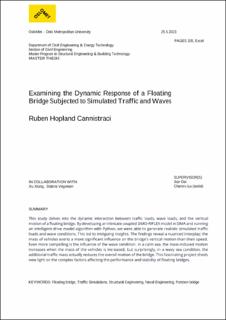| dc.description.abstract | This thesis forms part of the Ferry-Free E39 project, which seeks to reduce travel time and replace ferry connections along Norway's western coast. The project plans to replace seven ferry connections with alternative crossingss. A fjord 4500 meters wide named Bjørnefjoren was considered in this thesis. Since the fjord is too deep and wide for conventional bridge designs, a floating bridge design where chosen. Two main designs have been developed: a curved bridge selected for further devolopment and a straight bridge with side anchoring. In this project, the vertical responses of the girder and pontoons subjected to wave and traffic conditions were investigated using a SIMO-RIFLEX model. To simulate realistic traffic flow conditions, an Intelligent Drive Model (IDM) was coded in Python to generate authentic load sequences. This setup allows for large deformations, typical of long slender structures, and accommodates realistic environmental loads including wave, wind, and current simulations. The primary objective of this study is to explore how the bridge's vertical motion is influenced by incoming waves and varied traffic conditions, achieved through two distinct parts. First, a parametric study was conducted under calm sea conditions to develop an understanding on how individual vehicle parameters such as mass and speed, affected the bridge's vertical motion. Results suggested a linear relationship between vehicle mass and vertical motion, in addition it can be seen that the bridge is more responsive to changes in mass than speed. Since traffic flow is inherently random, a stochastic analysis was conducted to study the bridge's response under different traffic conditions. Simulations were run for free flow, capacity, and congested traffic flow under wave conditions, along with a free flow simulation under calm sea conditions. The results show that free-flow traffic resulted in the greatest vertical motion, most of which was attributed to wave response. Additionally, the results suggest that the mass of the traffic increases the bridge's inertia, making it less responsive. It should also be noted that congested flow led to a significantly greater draft. In summary, under calm sea conditions, greater mass and traffic increase bridge motion. However, in wavy conditions, the mass of the traffic appears to stabilize the bridge. Floating bridges are complex structures subjected to complex load conditions. This project underscores the utility of numerical models in addressing complex engineering challenges. | en_US |

